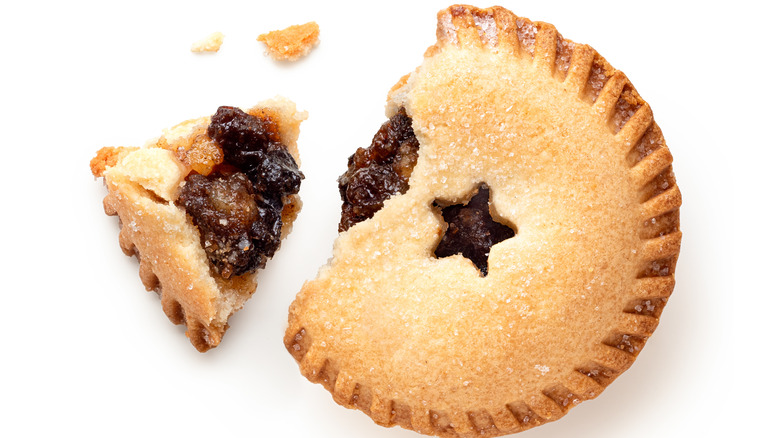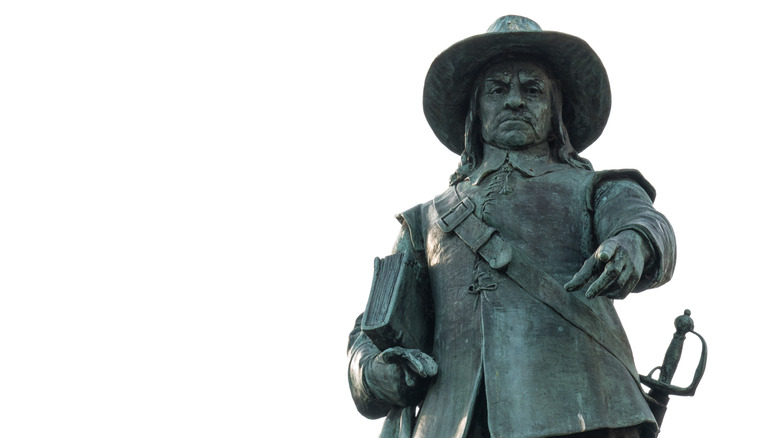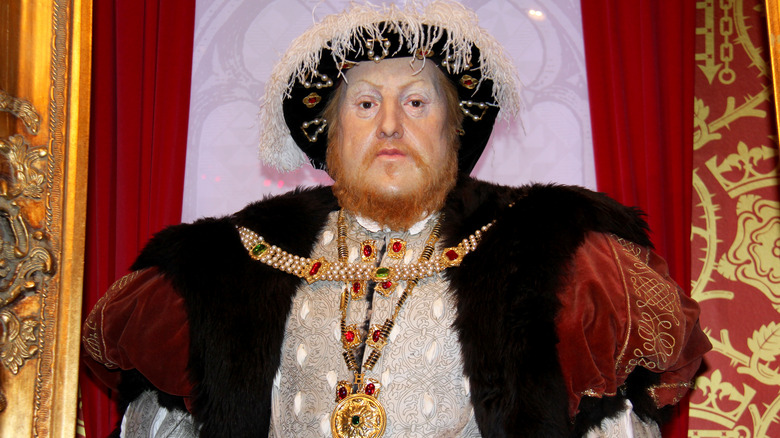Mince Pies Have Been Around Longer Than You Might Think
We may receive a commission on purchases made from links.
Let's not mince words –- for those of us here in the U.S., mince pies aren't exactly a much-loved part of our Christmas celebrations, and haven't been since back in the days when everyone wore hats, cravats, and spats (whatever those last two even are). At any rate, that time was not within living memory for most of us. Although commercially-made mincemeat is available in grocery stores, a glance at the label, such as one from the None Such brand (via Amazon), doesn't really make it seem like a tempting prospect for pie filling: Corn syrup, raisins, dried apples, molasses, corn starch, vinegar, dried citrus peel, salt, spices, beef, bitters, and fruit pectin. Umm, no thanks. We'll just stick with good old apple pie, all-American though it may not be.
Mince pies are still quite popular in the U.K., though, with BBC Future describing them as something that appears on everyone's holiday table year after year. According to the tale they relay, it seems that mince pies have been a staple of British cooking since back in the days when kirtles and cotehardies were the height of fashion.
Mince pies have changed quite a bit over the years
As BBC Future tells it, a recipe for mince pies first appeared in "print" back before the days of print, as it was featured on a 1390 scroll. (Gutenberg didn't come up with his history-changing invention until the following century). They weren't yet called mince pies, however, but instead went by the appetizing moniker "tartes of flesh." The recipe called for pork, cheese, and hard-boiled eggs mixed with sugar, spices, and saffron, a combination that actually sounds quite a bit tastier than modern-day mincemeat. Another recipe, dating from the early 17th century, calls for mutton, suet, currants, raisins, prunes, and dates flavored with orange peel, cloves, and mace. The 17th century also marks the era when mince pies started to be mentioned as a Christmastime treat.
Throughout the ages, mincemeat became, well, less meaty. As food historian Annie Gray, Ph.D. told AllRecipes, back in the late Tudor era, mince pies were 30% to 50% meat. But by the late 19th century, they often contained no meat whatsoever, although prior to the invention of vegetable shortening they were of necessity made with beef suet. (Luckily there weren't too many 19th century vegans around to object.) As for why mince pies lost their meat, Gray thinks this happened as a part of the culinary evolution that had us starting to separate our main dishes from desserts and decreeing that the former would be savory, the latter sweet, and seldom the twain should meet.
Mince pies were rumored to have been banned by the Puritans
As per AllRecipes, Christmas mince pies in the 16th and 17th centuries sometimes went beyond being merely pie-shaped. Special Christmas mince pies featured religious imagery such as baby Jesuses made from dough and sweets and spices meant to symbolize the gifts brought by the Three Wise Men. As Britain transitioned rather abruptly from Catholicism to Protestantism during the reign of King Henry VIII, such elaborate pies came to be seen as strictly a Catholic tradition.
This religious association led to rumors that mince pies of any sort had been outlawed by the Puritans who held power during Britain's brief 17th-century experiment in doing away with the monarchy. (Spoiler: Lord Protector Oliver Cromwell didn't exactly prove to be the people's friend.) As it turns out, BBC Future says the Puritans weren't opposed to mince pies so much as they were to everything to do with Christmas, period. They banned all such celebrations, but did not single out mince pies and presumably didn't mind these being eaten (minus any type of religion-themed decoration) at any other time of year.
They did figure in a Tudor-era scandal, though
In the century prior to Cromwell's rule, mince pies did figure in a scandal-turned-nursery rhyme. Not-so-jolly old soul King Henry VIII adopted a policy that came to be known to history as the Dissolution of the Monasteries. Starting in 1536, he kicked the monks and nuns out of their homes and kept the former abodes for his own use. According to AllRecipes, the Abbott of Glastonbury Abbey tried to save his establishment from the land-hungry monarch by tempting him with several other valuable properties owned by the Abbey. He had the deeds to these holdings baked into a mincemeat pie (not one containing four-and-twenty blackbirds; Different rhyme) and had it smuggled to the palace. The courier, however, a man by the name of Thomas Horner, "stuck in his thumb and pulled out a plum" -– not a prune, but the deed to a manor.
Needless to say, the Abbott didn't get to keep his abbey. In fact, he was later hanged for treason. Horner, however, got not only a manor for his troubles but a new nickname, that being "Little Jack," of course. It is to be noted, though, that nursery rhyme history isn't always accurate. As NPR explains, it is more likely that Mr. Horner (whose family retained the manor until last century) was a Protestant who was either granted the manor by the king himself or else purchased the property as his family maintains that he did.



